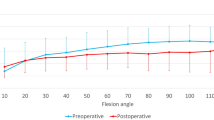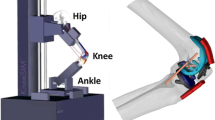Abstract
The purpose of this study was to compare knee kinematics in patients with bi-cruciate preserving total knee arthroplasty and posterior cruciate ligament (PCL) preserving total knee arthroplasty. Five knees received PCL-retaining arthroplasty and nine knees received both cruciate-retaining arthroplasty (ACL/PCL knees). We studied treadmill gait, stair stepping, and maximum flexion activities using lateral fluoroscopy and shape matching. For maximum flexion, the ACL/PCL knees showed 6 mm more posterior translation of the lateral condyle (p < 0.05). For the stair activity, posterior translations of the lateral condyle were significantly greater in the ACL/PCL knees from 30° to 70° flexion (p < 0.05). Both condyles in the ACL/PCL knees showed greater posterior translation in the stance and swing phases of gait than in the PCL knees (p < 0.05). Preserving both cruciate ligaments in total knee arthroplasty appears to maintain some basic features of normal knee kinematics in these activities.



Similar content being viewed by others
References
Alkjaer T, Simonsen EB, Jørgensen U, Dyhre-Poulsen P (2003) Evaluation of the walking pattern in two types of patients with anterior cruciate ligament deficiency: copers and non-copers. Eur J Appl Physiol 89:301–308
Alkjaer T, Simonsen EB, Magnusson SP, Aagaard H, Dyhre-Poulsen P (2002) Differences in the movement pattern of a forward lunge in two types of anterior cruciate ligament deficient patients: copers and non-copers. Clin Biomech 17:586–593
Andriacchi TP, Dyrby CO (2005) Interactions between kinematics and loading during walking for the normal and ACL deficient knee. J Biomech 38:293–298
Andriacchi TP, Galante JO, Fermier RW (1982) The influence of total knee replacement design on walking and stair climbing. J Bone Joint Surg Am 64A:1328–1335
Banks SA, Fregly BJ, Boniforti F, Reinschmidt C (2005) Comparing in vivo kinematics of unicondylar and bi-unicondylar knee replacements. Knee Surg Sports Traumatol Arthrosc 13:193–196
Banks SA, Harman MK, Hodge WA (2002) Mechanism of anterior impingement damage in total knee arthroplasty. J Bone Joint Surg Am 84A:37–42
Banks SA, Hodge WA (1996) Accurate measurement of three-dimensional knee replacement kinematics using single-plane fluoroscopy. IEEE Trans Biomed Eng 43:638–649
Banks SA, Hodge WA (2004) Design and activity dependence of kinematics in fixed and mobile bearing knee arthroplasties. J Arthroplasty 19:809–816
Banks SA, Hodge WA (2004) Implant design affects knee arthroplasty kinematics during stair-stepping. Clin Orthop 426:187–193
Banks SA, Markovich GD, Hodge WA (1997) In vivo kinematics of cruciate retaining and substituting knee replacements. J Arthroplasty 12:297–304
Berchuck M, Andriacchi TP, Bach BR, Reider B (1990) Gait adaptations by patients who have a deficient anterior cruciate ligament. J Bone Joint Surg Am 72A:871–877
Canny JA (1986) Computational approach to edge detection. IEEE Trans Pattern Anal Mach Intell 8:679–698
Cloutier JM, Sabouret P, Deghrar A (1999) Total knee arthroplasty with retention of both cruciate ligaments: a nine to eleven-year follow-up study. J Bone Joint Surg Am 81A:697–702
Dennis DA, Komistek RD, Mahfouz MR, Hass DB, Stiehl JB (2003) Multicenter determination of in vivo kinematics after total knee arthroplasty. Clin Orthop 416:37–57
Dennis DA, Mahfouz MR, Komistek RD, Hoff W (2005) In vivo determination of normal and anterior cruciate ligament-deficient knee kinematics. J Biomech 38:241–253
Goodfellow J, O’Connor J (1992) The anterior cruciate ligament in knee arthroplasty: a risk-factor with unconstrained meniscal prostheses. Clin Orthop 276:245–252
Harman MK, Banks SA, Hodge WA (2001) Polyethylene damage and knee kinematics after total knee arthroplasty. Clin Orthop 392:383–393
Hass BD, Komistek RD, Dennis DA (2002) In vivo kinematics of the low contact stress rotating platform total knee. Orthopedics 25:s219–s226
Hill PF, Vedi V, Williams A, Iwaki H, Pinskerova V, Freeman MAR (2000) Tibiofemoral movement 2: the loaded and unloaded living knee studied by MRI. J Bone Joint Surg Br 82B:1196–1198
Insall JN (1988) Presidential address to the knee society: choices and compromises in total knee arthroplasty. Clin Orthop 226:43–48
Insall JN, Dorr LD, Scott RD, Scott WN (1989) Rationale of the knee society clinical rating system. Clin Orthop 248:13–14
Iwaki H, Pinskerova V, Freeman MAR (2000) Tibio-femoral movement 1: the shapes and relative movements of the femur and tibia in the unloaded cadaver knee. J Bone Joint Surg Br 82B:1189–1195
Jenny JY, Jenny G (1998) Preservation of anterior cruciate ligament in total knee arthroplasty. Arch Orthop Trauma Surg 118:145–148
Kanekasu K, Banks SA, Honjo S, Nakata O, Hiromi K (2004) Fluoroscopic analysis of knee arthroplasty kinematics during deep flexion kneeling. J Arthroplasty 19:998–1003
Kärrholm J, Selvik G, Elmqvist LG, Hansson LI (1988) Active knee motion after cruciate ligament rupture. Acta Orthop Scand 59:158–164
Kim YH (1990) Knee arthroplasty using a cementless PCA prosthesis with a porous coated central tibial stem. J Bone Joint Surg Br 72B:412
Komistek RD, Allain J, Anderson DT, Dennis DA, Goutallier D (2002) In vivo kinematics for subjects with and without an anterior cruciate ligament. Clin Orthop 404:315–325
Misra AN, Hussain RA, Fiddian NJ, Newton G (2003) The role of the posterior cruciate ligament in total knee replacement. J Bone Joint Surg Br 85B:389–392
Myles CM, Rowe PJ, Walker CRC, Nutton RW (2002) Knee joint functional range of movement prior to and following total knee arthroplasty measured using flexible electrogoniometry. Gait Posture 16:46–54
Nabeyama R, Matsuda S, Miura H, Kawano T, Nagamine R, Mawatari T, Tanaka K, Iwamoto Y (2003) Changes in antero-posterior stability following total knee arthroplasty. J Orthop Sci 8:526–531
Nozaki H, Banks SA, Suguro T, Hodge WA (2002) Observations of femoral rollback in cruciate-retaining knee arthroplasty. Clin Orthop 404:308–314
Pritchett JW (1996) Anterior cruciate-retaining total knee arthroplasty. J Arthroplasty 11:194–197
Pritchett JW (2004) Patient preferences in knee prostheses. J Bone Joint Surg Br 86B:979–982
Scott RD, Volatile TB (1986) Twelve years experience with posterior cruciate-retaining total knee arthroplasty. Clin Orthop 205:100–107
Shelburne KB, Pandy MG, Torry MR (2004) Comparison of shear forces and ligament loading in the healthy and ACL-deficient knee during gait. J Biomech 37:313–319
Stiehl JB, Komistek RD, Cloutier JM, Dennis DA (2000) The cruciate ligaments in total knee arthroplasty: a kinematic analysis of 2 total knee arthroplasties. J Arthroplasty 15:545–550
Suggs JF, Li G, Park SE, Steffensmeier S, Rubash HE, Freiberg AA (2004) Function of the anterior cruciate ligament after unicompartmental knee arthroplasty: an in vitro robotic study. J Arthroplasty 19:224–229
Tupling S, Pierrynowski M (1987) Use of Cardan angles to locate rigid bodies in three-dimensional space. Med Biol Eng Comput 25:527–532
Author information
Authors and Affiliations
Corresponding author
Rights and permissions
About this article
Cite this article
Moro-oka, Ta., Muenchinger, M., Canciani, JP. et al. Comparing in vivo kinematics of anterior cruciate-retaining and posterior cruciate-retaining total knee arthroplasty. Knee Surg Sports Traumatol Arthr 15, 93–99 (2007). https://doi.org/10.1007/s00167-006-0134-6
Received:
Accepted:
Published:
Issue Date:
DOI: https://doi.org/10.1007/s00167-006-0134-6




